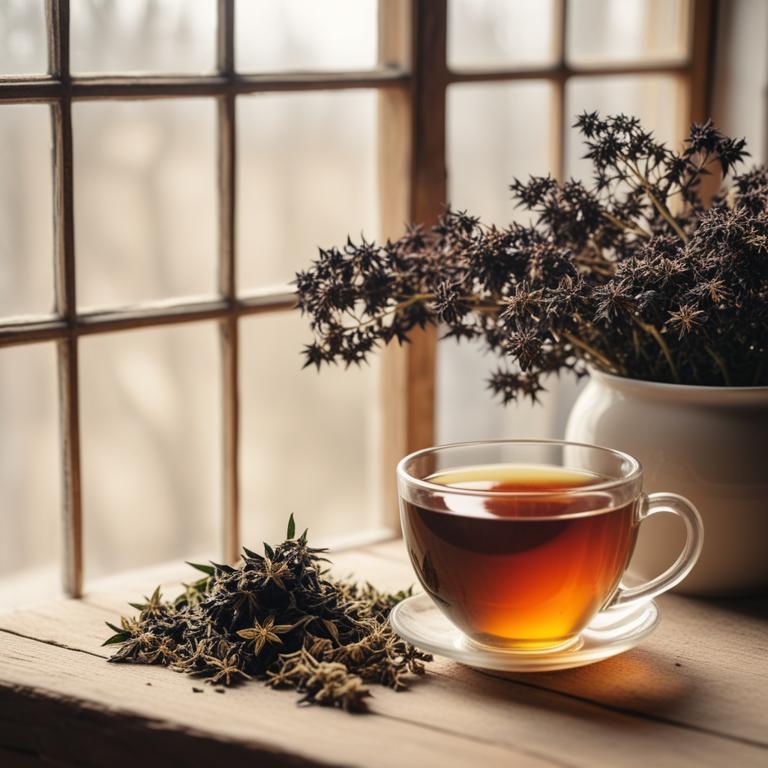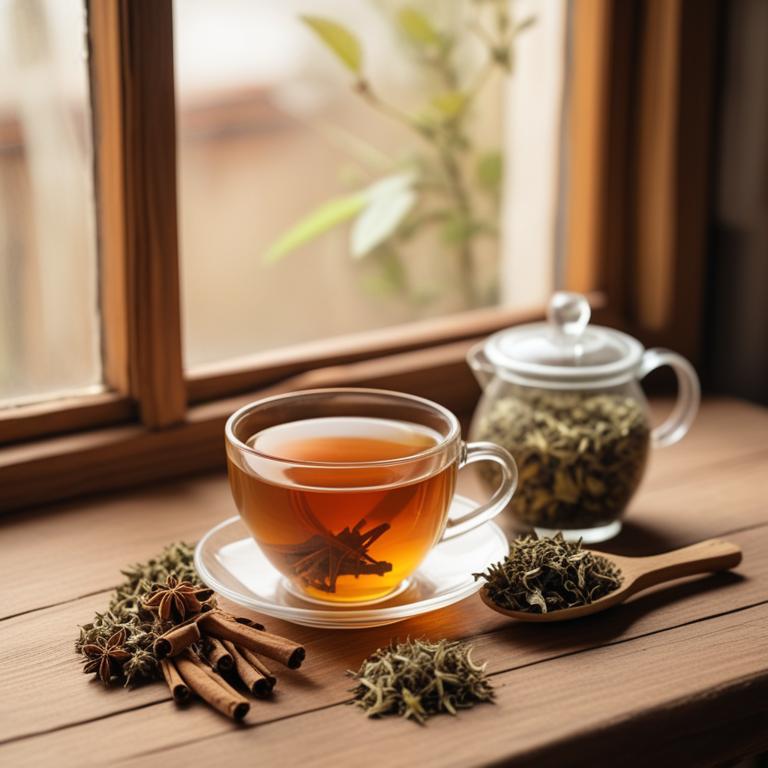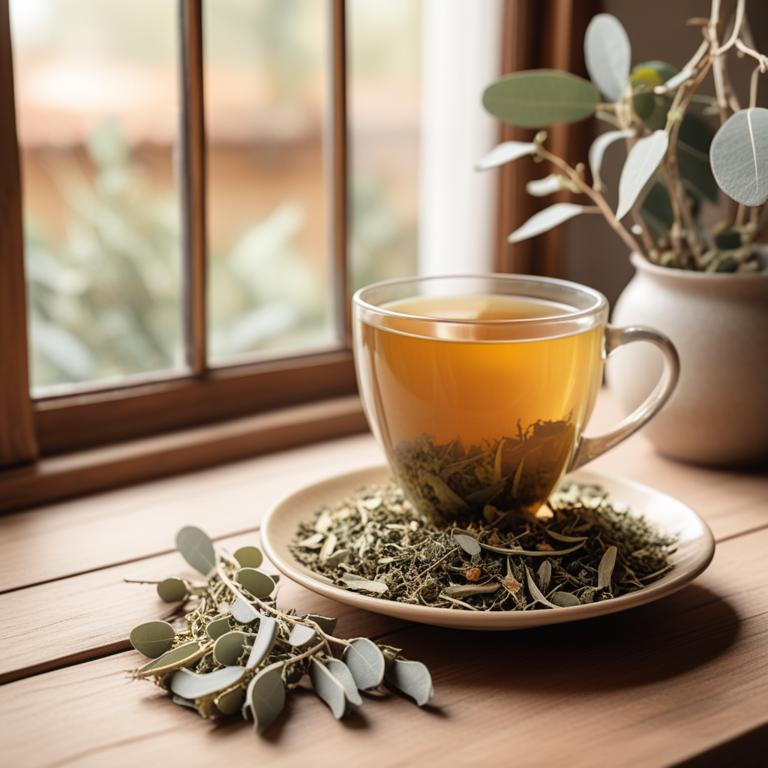9 Herbal Teas For Feverish Feeling

Herbal teas can be a great way to relieve a feverish feeling.
When you're not feeling well, your body is trying to fight off an infection. Herbal teas like ginger (Zingiber officinale) can help soothe your stomach and calm your body. Ginger has anti-inflammatory properties that can reduce nausea and ease discomfort. Another herb that's often used to combat fever is Echinacea purpurea. This herb helps boost your immune system, which is essential when you're feeling unwell. By drinking Echinacea tea, you can help your body recover faster and feel better sooner.
Elderberry (Sambucus nigra) is another herb that's often used to treat fever and flu. It has antiviral properties that can help fight off the infection and reduce its symptoms. Elderberry tea can also help ease a sore throat and reduce congestion. These herbal teas can bring many benefits to your life. They're a natural way to relieve a fever, without the need for medication. They can also help you recover faster, which means you can get back to your normal routine sooner.
Plus, herbal teas are often caffeine-free, making them a great option for people who are sensitive to caffeine.
- 1. Zingiber officinale
- 2. Echinacea purpurea
- 3. Sambucus nigra
- 4. Cinchona officinalis
- 5. Eucalyptus globulus
- 6. Ginkgo biloba
- 7. Lavandula angustifolia
- 8. Melissa officinalis
- 9. Glycyrrhiza glabra
1. Zingiber officinale

Zingiber officinale teas contains a compound called gingerol, which is responsible for its medicinal properties.
Gingerol has anti-inflammatory properties, which help reduce swelling and ease pain associated with fever. The tea also contains shogaol, a compound that has been shown to have antipyretic properties, which help lower body temperature. Additionally, Zingiber officinale teas contain compounds like zingerone and paradol, which have been found to have antioxidant and antiviral properties, helping to combat the underlying cause of fever.
By consuming Zingiber officinale teas, you can potentially alleviate symptoms of fever and promote a faster recovery.
- Gather 1 cup of water and 1 tablespoon of fresh ginger root (Zingiber officinale).
- Peel the ginger root and slice it thinly. Add the sliced ginger to the cup of water.
- Heat the water over medium heat for 5-7 minutes, or until the water starts boiling.
- Reduce the heat to low and let it simmer for 10-15 minutes, allowing the ginger to infuse into the water.
- Strain the liquid and discard the ginger. Let the tea cool down, then drink it as needed to help alleviate a feverish feeling.
Zingiber Officinale Tea on Amazon
FGO Organic Ginger Tea, 100 Count, Eco-Conscious Tea Bags, Caffeine Free, Packaging May Vary (Pack of 1)
Disclaimer: We earn a commission if you click this link and make a purchase at no additional cost to you.
2. Echinacea purpurea

Echinacea purpurea teas contains a group of biologically active constituents called alkylamides and caffeic acid derivatives.
These compounds have anti-inflammatory properties, which can help reduce swelling and ease discomfort. Echinacea purpurea also contains polysaccharides, which are complex sugars that can stimulate the immune system and increase its ability to fight off infections. The flavonoids present in Echinacea purpurea, such as kaempferol and quercetin, have antioxidant properties that can help protect the body from oxidative stress caused by fever.
By reducing inflammation, stimulating the immune system, and protecting against oxidative stress, Echinacea purpurea teas can help alleviate symptoms associated with feverish feelings.
- Gather 2 teaspoons of dried Echinacea purpurea root and flowers.
- Boil 1 cup of water in a pot.
- Add the Echinacea purpurea mixture to the boiling water.
- Steep the mixture for 5-7 minutes, then strain.
- Drink the tea warm or at room temperature, 2-3 times a day as needed.
3. Sambucus nigra

Sambucus nigra teas contains compounds like flavonoids, terpenes, and phenolic acids that contribute to its therapeutic properties.
The flavonoids present in Sambucus nigra, such as quercetin and kaempferol, have anti-inflammatory properties, which can help reduce fever and alleviate symptoms associated with it. The terpenes, including limonene and beta-pinene, have been shown to have a cooling effect on the body, which can help lower temperature. The phenolic acids, including chlorogenic and caffeic acids, also exhibit anti-inflammatory and antioxidant properties that can aid in reducing fever.
By consuming Sambucus nigra teas, individuals may experience relief from feverish feelings due to its bioactive constituents working together to soothe and calm the body.
- Gather 2 tablespoons of dried Sambucus nigra flowers and a cup of boiling water.
- Put the flowers in a cup or teapot and pour in the boiling water.
- Let the mixture steep for 5-7 minutes, then strain it into another cup.
- Add honey to taste, if desired, and stir well.
- Drink the tea 2-3 times a day to help relieve feverish feelings.
4. Cinchona officinalis

Cinchona officinalis teas contains a number of bioactive compounds, including quinine and quinidine, which have antipyretic and anti-inflammatory properties.
These compounds help to reduce fever by decreasing the production of prostaglandins, hormone-like substances that cause blood vessels to dilate and lead to increased body temperature. The alkaloids in Cinchona officinalis also have a direct effect on the hypothalamus, the part of the brain that regulates body temperature. This action helps to cool the body and reduce the sensation of fever.
The antipyretic properties of Cinchona officinalis teas make it a popular remedy for reducing fever and alleviating related symptoms.
- Gather 1 tablespoon of dried Cinchona officinalis bark. You can find it at a health food store or online.
- Boil 1 cup of water in a pot.
- Add 1 tablespoon of dried Cinchona officinalis bark to the boiling water.
- Reduce heat and let it simmer for 5-7 minutes. Strain the mixture into a cup.
- Drink the tea while it's still warm. Repeat as needed for feverish feeling.
5. Eucalyptus globulus

Eucalyptus globulus teas contains compounds like eucalyptol and cineole, which have anti-inflammatory and decongestant properties.
These properties help to reduce swelling in the body and clear congestion in the airways, making it easier to breathe. The menthol in Eucalyptus globulus also helps to cool the body and reduce fever. Additionally, the tea's antioxidant properties help to protect the body from damage caused by free radicals, which can contribute to feverish feelings.
By reducing inflammation and promoting healthy breathing, Eucalyptus globulus teas can help to alleviate symptoms of fever and promote a sense of well-being.
- Gather 1 cup of fresh eucalyptus leaves (Eucalyptus globulus) or 1 teaspoon of dried eucalyptus leaves.
- Combine the eucalyptus leaves with 1 cup of boiling water in a heat-resistant cup.
- Let it steep for 5-7 minutes to allow the eucalyptus essence to mix with the water.
- Strain the liquid using a fine-mesh sieve or cheesecloth to remove the eucalyptus leaves.
- Drink the eucalyptus tea as needed for a feverish feeling, ideally in small amounts (1/2 cup) every 2 hours.
6. Ginkgo biloba

Ginkgo biloba teas contains flavonoids and terpenoids, two types of bioactive compounds.
These compounds have anti-inflammatory and antioxidant properties, which help reduce swelling and fight off free radicals that can contribute to fever. The flavonoids, particularly quercetin and kaempferol, also have a cooling effect on the body, which can help bring down a fever. Additionally, the terpenoids, including ginkgolides and bilobalide, have antipyretic properties, meaning they can directly help lower body temperature.
By combining these properties, Ginkgo biloba teas may provide relief from feverish feelings.
- Gather 1 teaspoon of dried Ginkgo biloba leaves and 1 cup of boiling water.
- Steep the Ginkgo biloba leaves in the boiling water for 5-7 minutes.
- Strain the mixture into a cup to remove the leaves.
- Add 1 tablespoon of honey (optional) to the tea for taste.
- Drink the tea while it's still warm to help with a feverish feeling.
7. Lavandula angustifolia

Lavandula angustifolia teas contains a high concentration of linalool and linalyl acetate, two powerful compounds known for their calming and fever-reducing properties.
These bioactive constituents work together to help lower body temperature and reduce inflammation, making Lavandula angustifolia a popular natural remedy for feverish feelings. The antipyretic and anti-inflammatory properties of linalool and linalyl acetate in Lavandula angustifolia teas help to alleviate symptoms of fever, such as sweating and chills. Additionally, the soothing effects of these compounds can also promote relaxation and reduce stress, further contributing to a sense of comfort and well-being.
By incorporating Lavandula angustifolia teas into your routine, you can tap into the natural fever-reducing properties of this herb.
- Gather 1 cup of fresh or dried Lavandula angustifolia flowers.
- Measure 1 tablespoon of flowers and place them in a tea infuser or a heat-resistant cup.
- Boil 1 cup of water and pour it over the flowers in the tea infuser or cup.
- Let it steep for 5-7 minutes, then strain the tea into another cup using a spoon or tea strainer.
- Drink the tea while it's still warm, 2-3 times a day, to help soothe a feverish feeling.
8. Melissa officinalis

Melissa officinalis teas contains the bioactive constituents rosmarinic acid and linalool, which have anti-inflammatory properties that help reduce fever.
The antipyretic properties of Melissa officinalis help lower body temperature by inhibiting the production of prostaglandins, hormone-like substances that cause inflammation and fever. The tea's antiviral and antibacterial properties also help combat infections that may be causing the fever. Additionally, Melissa officinalis tea's calming effects can help alleviate stress and anxiety, which can exacerbate feverish feelings.
By reducing inflammation and infection, and promoting relaxation, Melissa officinalis tea can provide relief from feverish feelings.
- Gather 1 cup of fresh Melissa officinalis leaves or 2 teaspoons of dried leaves.
- Heat 1 cup of water in a pot until it boils.
- Add the Melissa officinalis leaves to the boiling water, then reduce heat to low.
- Steep the mixture for 5-7 minutes, then strain it using a fine-mesh sieve into a cup.
- Drink the tea while still warm, 2-3 times a day as needed.
9. Glycyrrhiza glabra

Glycyrrhiza glabra teas contains compounds like glycyrrhizin and flavonoids, which have anti-inflammatory properties.
These properties can help reduce inflammation in the body, which may be contributing to fever. Glycyrrhizin also has antiviral properties, which can help fight off the underlying cause of the fever. Flavonoids, such as liquiritigenin, have antioxidant properties, which can help protect the body from damage caused by free radicals during a fever.
By reducing inflammation and fighting off infections, Glycyrrhiza glabra teas may help alleviate feverish feelings.
- Gather 1 cup of boiling water and 1 teaspoon of dried Glycyrrhiza glabra root.
- Place the Glycyrrhiza glabra root in a tea infuser or a heat-resistant cup.
- Pour the boiling water over the root and let it steep for 5-7 minutes.
- Strain the tea into a cup using the tea infuser or a piece of cheesecloth.
- Drink 1/2 cup of the tea 2-3 times a day to help reduce feverish feeling.